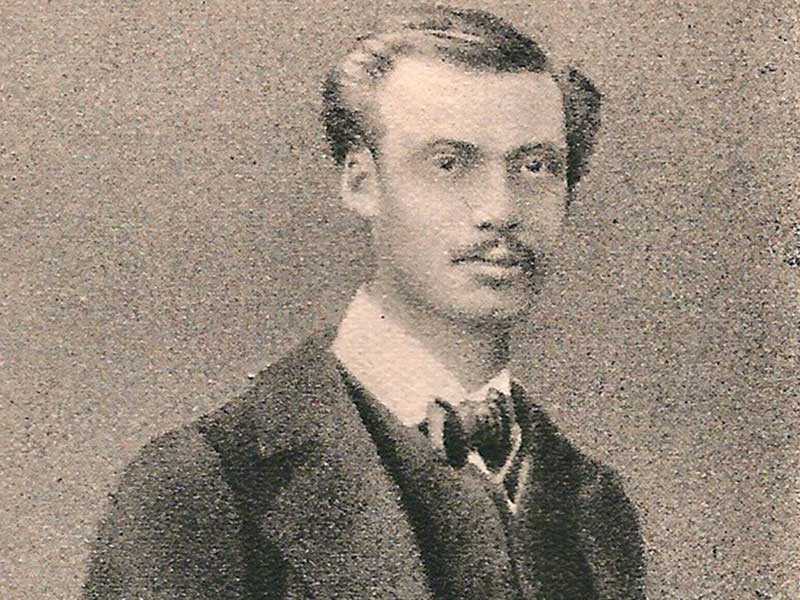1. La Loge (1874)
One of Renoir’s most striking paintings from the 1870s, ‘La Loge’ or ‘The Theatre Box’ is classic of the Impressionists’ aim to paint modern life.
During the 19th century, the theatre became established as one of the central meeting places for the upper and middle classes.

No longer the reserve of just the wealthiest members of society, the theatre became more accessible during this period thanks to a number of changes to the way tickets were marketed and sold.
In painting ‘La Loge’, Renoir followed a dominant theme among the Impressionists at this time. Berthe Morisot, Mary Cassatt, Degas and Manet all painted scenes from the theatre.
This particular painting was Renoir’s principle piece in the First Impressionist Exhibition of 1874.
Renoir places the viewer just in front of the theatre box where a couple is seated. An elegantly dressed woman looks directly at the viewer while the man seated behind her peers through a pair of opera glasses.
By positioning the work in this way, Renoir placed the spectacle on the couple rather than what was happening on stage. This technique, which was also used by other Impressionists, established the theatre as a social stage where the goal was to observe and be observed.
Another notable example of Renoir’s theatre-themed works is ‘At the Theatre’ (La Première Sortie) from 1876-77. His later work, ‘At the Concert’ from 1880 is also an opulent, sparkling example of the subject.
2. La Parisienne (1874)
Once owned by Henri Rouart, ‘La Parisienne’ features the actress Henriette Henriot, dressed as a modern Parisian woman in the latest fashions of the day.
There is no other detail in the painting to provide context, instead the figure is definable only by her face and clothes. In doing so, Renoir made Henriot into a symbol of Paris.
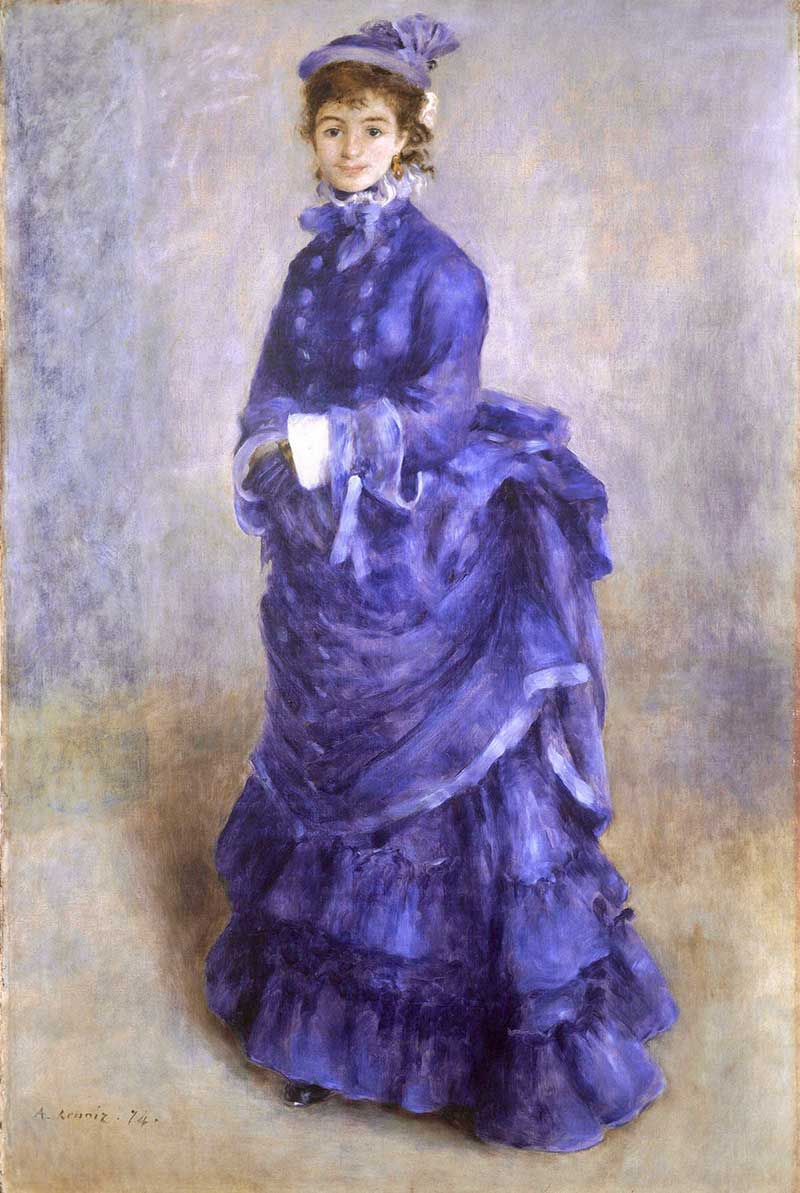
She is painted as a typical urban woman: independent, stylish and brimming with confidence.
This piece was shown at the First Impressionist Exhibition in 1874. One critic noted,
“The toe of her ankle boot is almost invisible, and peeps out like a little black mouse. Her hat is tilted over one ear and is daringly coquettish […] The smile is false, and the face is a strange mixture of the old and the childish. But there is still something naive about her. One gets the impression that this little lady is trying hard to look chaste. The dress, which is extremely well painted, is a heavenly blue.”
The painting also attracted a great deal of criticism. The blue of the figure’s clothing sets her apart from the more respectable women of Paris, who one would expect to be seen in blacks or greys.
Her hair is also pinned loosely, with strands falling down to frame her face. This figure is distinctly different from the women traditionally depicted in history paintings and religious paintings that dominated the art world at this time.
It therefore represents the more daring aspects of Impressionism in the 1870s.
Interesting fact...
La Parisienne, now one of the gems of the collection of the National Museum Cardiff, is a life-sized painting. It measures 163.5 x 108.5 centimetres.
3. Bal du moulin de la Galette (1876)
A wonder of early Impressionism, ‘Bal du moulin de la Galette’ captures the energy and vivaciousness of Parisian life during the mid 1870s.
Renoir depicts a bustling crowd at a dance garden on the Butte Montmartre, one of the most popular and notorious neighbourhoods in Paris.
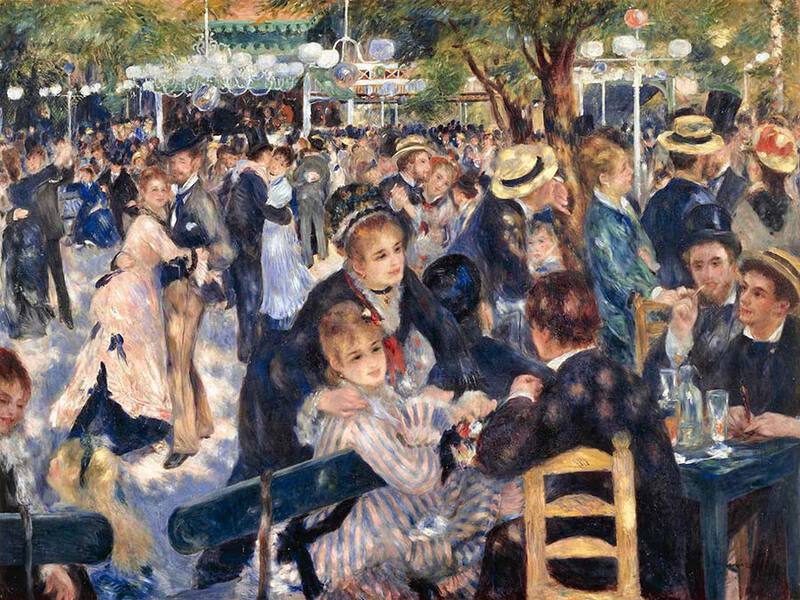
In painting the scene, Renoir was documenting urban Paris at leisure, highlighting the animation of the crowd in the groups both seated and standing and the couples dancing.
In this work, Renoir played with the effects of natural and artificial light, casting a dappled effect on the clothes and faces of the crowd.
He used short brushstrokes and a rich colour palette to build up the painting, utilising the techniques that the Impressionists were experimenting with during this period. The characters in the foreground were friends of the artist and he was as much a participant as a documenter in this familiar scene.
This painting was exhibited at the 1877 Impressionist Exhibition, hung on a wall of its own.
Reviews of the works were mixed but perhaps the most glowing critique was from Stephane Mallarme writing:
“The strong daylight is filtered through the greenery, setting the blonde hair and pink cheeks of the girls aglow and making their ribbons sparkle. The joyful light fills every corner of the canvas and even the shadows reflect it. The whole painting shimmers like a rainbow”.
4. Luncheon of the Boating Party (1880-81)
Perhaps Renoir’s most famous work, ‘Luncheon of the Boating Party’ is now a symbol of the Impressionist movement and French painting from the 19th century.
What makes the painting so engaging is the sense of life it exudes. The characters in the work are rosy cheeked and casual, arranged in a way that feels unposed and spontaneous.
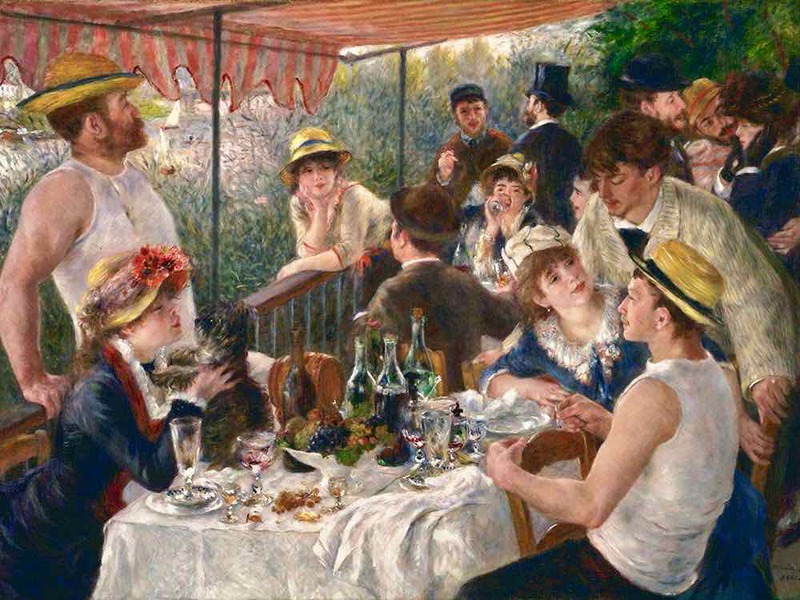
Renoir’s characteristic quick brushstrokes and rich colour palette help to heighten this feeling.
Renoir paid a great deal of attention to the contemporary fashions of his figures. He took care to capture the details on the women’s dresses and hats and the delicate stripes on the jacket worn by the man on the right of painting.
These details may hint at his childhood experiences as the son of a dressmaker and tailor.
The scene was painted on the balcony of the Maison Fournaise, a restaurant and hotel located conveniently close to Paris, on the banks of the Îsle de Chatou. Behind the foliage and the red-striped awning of the terrace, it is possible to make out sailing boats on the Seine.
This painting is thus typical of Impressionist works capturing wealthy, glamorous Parisians at their leisure. Its grand scale at 51 x 68 inches (130 x 173 cm) also makes it one of Renoir’s largest works.
Luncheon of the Boating Party is one of our 10 Best Impressionist Paintings.
5. Moulin Huet Bay, Guernsey (1883)
Breaking with the techniques of the Impressionist movement, Renoir began producing finished paintings in his studio rather than working en plein air during the 1880s.
However, ‘Moulin Huet Bay, Guernsey’ is an example of a quick oil sketch that he would have made on location.
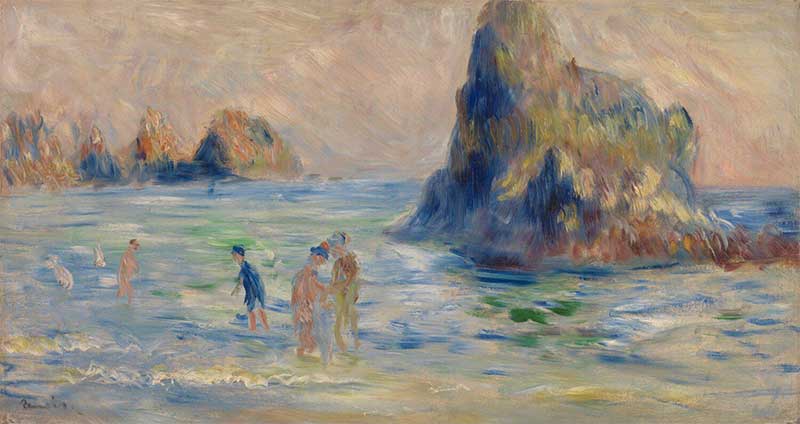
Renoir was inspired to paint the scene during a visit to Guernsey in the autumn of 1883. While staying on the island for six weeks, he discovered a “charming beach” where
“one bathes among the rocks, […] nothing prettier than this blending of women and men crowded on these rocks.”
These views provided a “source of real motifs, graceful, which I will be able to use.”
The artist was so captivated by the Guernsey coast that he only painted seascapes and beach scenes during his stay. In particular, he worked on capturing the effects of reflections on the water and the waves.
This particular work is roughly made, giving it an infectious feeling of spontaneity. The figures are made up of just a few brief brushstrokes and would have been added to the work while the paint was still wet. It is very likely that the entire painting was done in one session.
This sketch draws on the Impressionists’ interest in natural light. Renoir pays particular attention to the way the sunlight reflects on the rocks and the surface of the sea. He used a bright colour palette with paler highlights to capture the effect of the sun-drenched setting.
6. Danse a la Ville (1883)
‘Danse à la ville’ or ‘City Dance’ was painted as part of a pair along with ‘Danse à la campagne’ or ‘Country Dance’.
These two works were intended to showcase the different forms of dancing between the urban and rural population and they can almost be seen as opposites of one another.
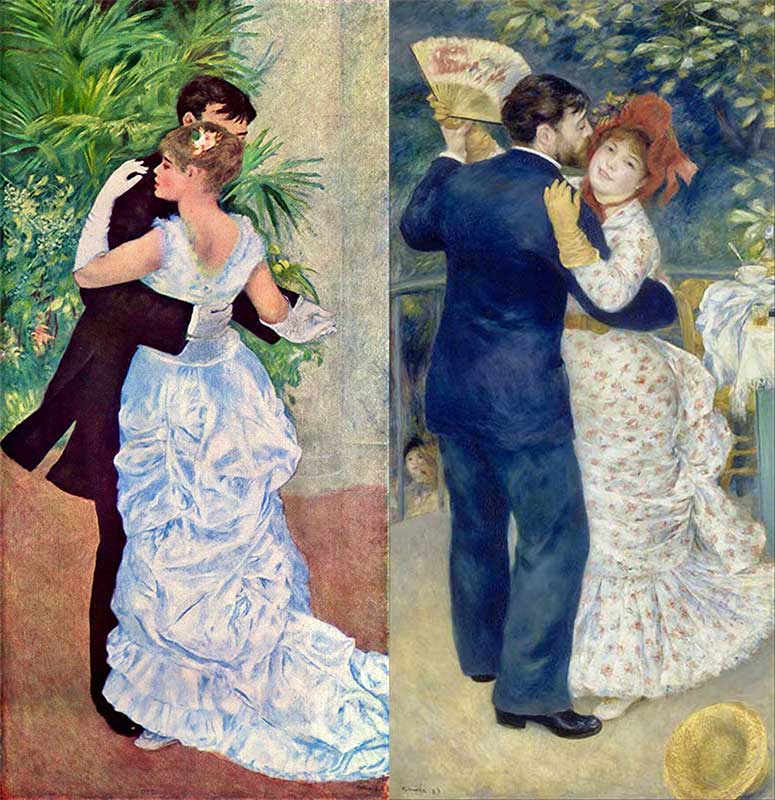
In these almost life-size paintings, two dancers are pictured at the same moment in the same dance yet placed in entirely different settings.
‘Danse à la ville’ depicts an elegant pair in evening dress, with restrained colours and the sculptural plants of a city ballroom behind them. In contrast, ‘Danse à la campagne’ is painted in a blushing palette, with the female figure’s red bonnet and rosy cheeks facing the viewer.
In the latter piece, the couple appear to have stood up from a table to dance, giving the painting a feeling of spontaneity and freedom.
The works represent a stylistic change for Renoir that began in the early 1880s when he began to move away from Impressionism. As he later reflected to Ambroise Vollard,
"I had come to the end of Impressionism, and was reaching the conclusion that I didn’t know how either to paint or draw. In a word, I was at a dead end.”
After a trip to Italy, where he saw the work of Raphael, Renoir decided to begin pursuing a more precise form of painting. He also simplified his palette dramatically.
There are a number of similarities between these works and Renoir’s other well-known painting, ‘Dance at Bougival’, also from 1883.
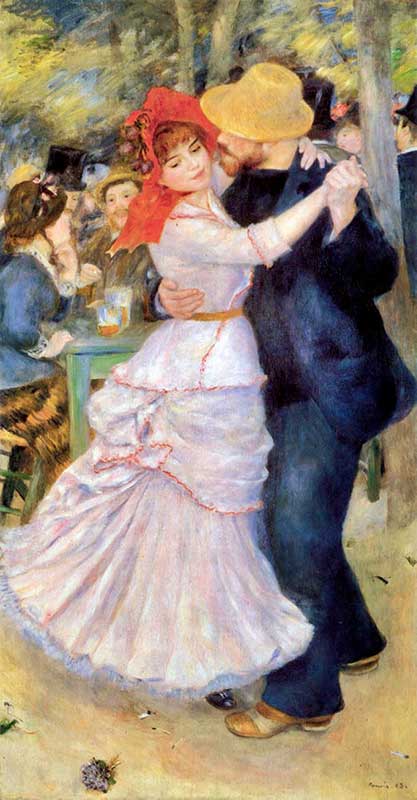
The intricate details of the dancers’ clothing and the romantic atmosphere of the scene echoes the carefree feeling captured in ‘Danse à la campagne’ in particular.
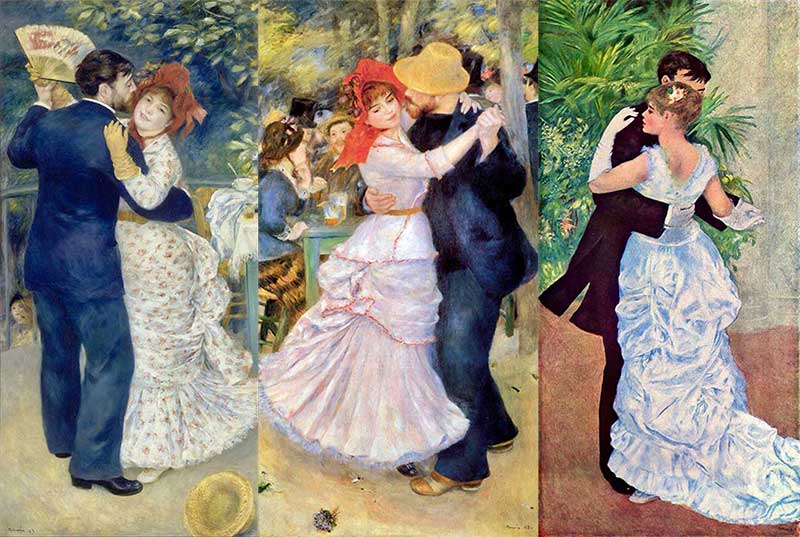
7. The Umbrellas (1881-86)
This painting by Renoir is unusual in that it was painted over a period of five years.
The artist began the piece around 1880-81, returning the finish the work around 1884-85. He eventually completed it in time to be shown at an exhibition of Impressionist art in New York in 1886.
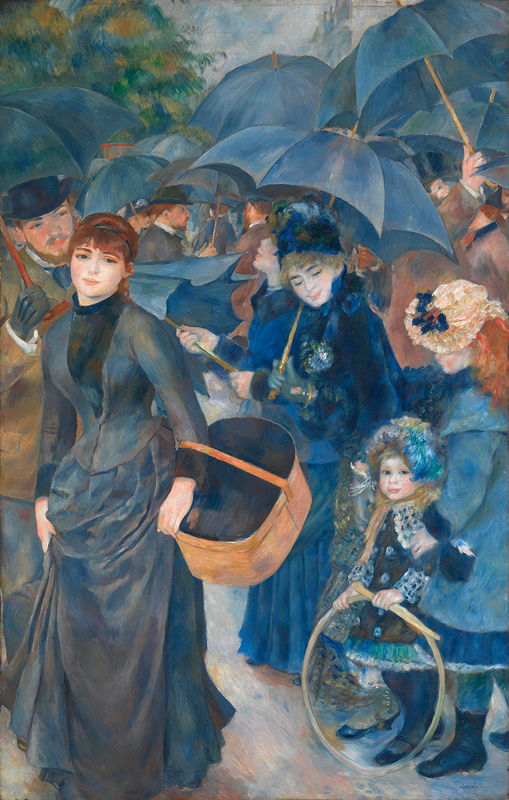
What results from this drawn out painting process is a piece that shows the gradual transition of Renoir’s style during the first half of the 1880s.
On the right hand side, one can see the beginning of the painting. The figures are Impressionist in style, painted side-on and formed using light, quick brushstrokes.
To paint a mother and her two daughters, as well as a figure opening up her umbrella, Renoir used a palette of rich greens, blues and orange. The figures don’t have solid outlines and instead have an almost feathered appearance.
In contrast, the second half of the painting on the left side is far more uniform. The figures are more clearly defined with clearer outlines and solid features. This section of the painting has more of a three-dimensional effect.
Within ‘The Umbrellas’, it is even possible to track the changes in fashion through the 1880s. The women on the right wear clothes that were fashionable around 1881. However, in the years between starting and finishing the painting, fashions evolved.
As a result, the cut of the dress worn by the woman on the left side of the painting is quite different, mimicking a design that became popular around 1885.
8. Two Young Girls at the Piano (1892)
Renoir painted the same scene of two girls practicing piano over six times.
In every piece, the composition is almost identical with one girl seated, sight reading the music and the other girl leaning over her.
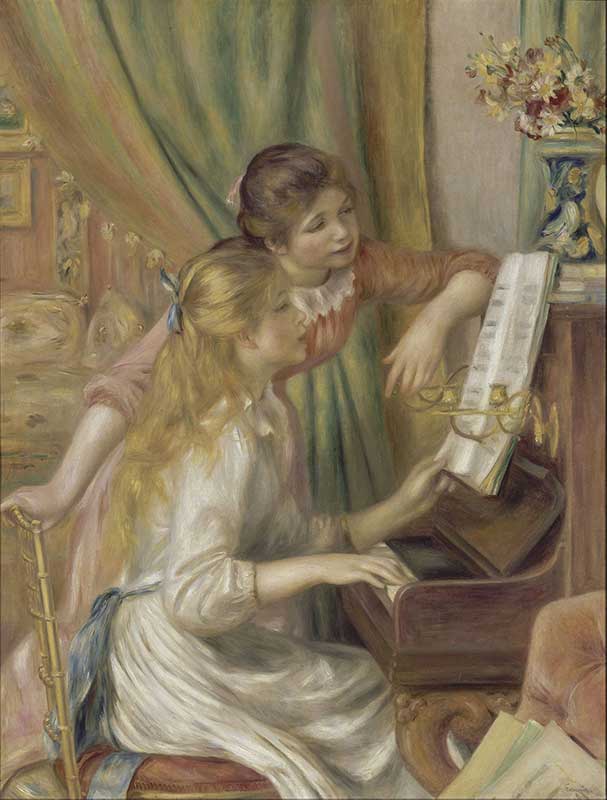
The work was commissioned by the French government in 1892 to be placed in the new Musée du Luxembourg, a museum that would be dedicated to the work of living artists. Hence, Renoir devoted much of his time to creating the perfect piece.
It is possible that this painting was produced in Renoir’s home as we know that he bought his wife a piano in 1890. In every version of the painting, the same models pose at the piano. Of the six canvasses Renoir recorded, one of the most beautiful went into the private collection of Impressionist painter Gustave Caillebotte.
Like many artists of the Impressionist movement, including Paul Cezanne, Edgar Degas and Edouard Manet, Renoir enjoyed painting modern, domestic scene. During the 19th century, pianos became a common fixture in the homes of middle class families in France. This was partly helped by the availability of cheap sheet music thanks to new printing techniques and the mass production of pianos.
The geometric lines within the painting combined with the soft curves of the young girl’s faces and bodies reference classical paintings. However, the painting is characteristic of the Impressionist movement with light, feathery brushstrokes which give the work a hazy appearance typical of Renoir’s later work.
9. Misia Sert (1904)
As Renoir became more established in his career, he frequently had the opportunity to paint wealthy members of upper class Parisian society.
One such example is ‘Misia Sert’ from 1904, a portrait depicting a famous pianist and society woman.
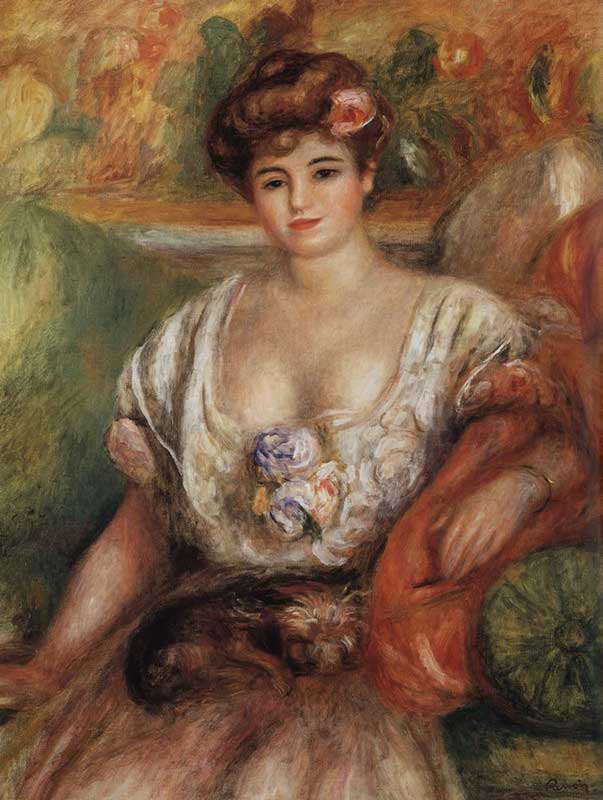
Misia Sert was a central figure in the artistic circles of France. She held a position of enormous influence during the late 19th and early 20th century, so much so that she was known as the ‘Queen of Paris’.
Having learnt piano from Gabriel Fauré, Sert forwent a career as a professional pianist and instead established herself at the heart of Parisian social life, hosting soirees and private concerts.
She maintained close ties with all of the most famous authors, poets, composers and painters of her day and her influence on Parisian society during this period cannot be understated.
Renoir painted Sert’s portrait between seven and eight times. This particular painting from 1904 depicts Sert in a glamorous dress, leaning on a chaise long with a string of pearls around her neck.
Her facial expression is ambiguous, appearing almost as a mask. She gives very little of her inner thoughts away to the viewer. The portrait remained in Sert’s possession until her death in 1950.
10. The Bathers (1918-19)
As he neared the end of his life and became increasingly ill, Renoir returned to the subject of female nudes painted in natural settings.
These paintings drew on the classical tradition of mythical nudes in Mediterranean inspired landscapes, characterised by intense colours and the sensuality of the models’ forms.
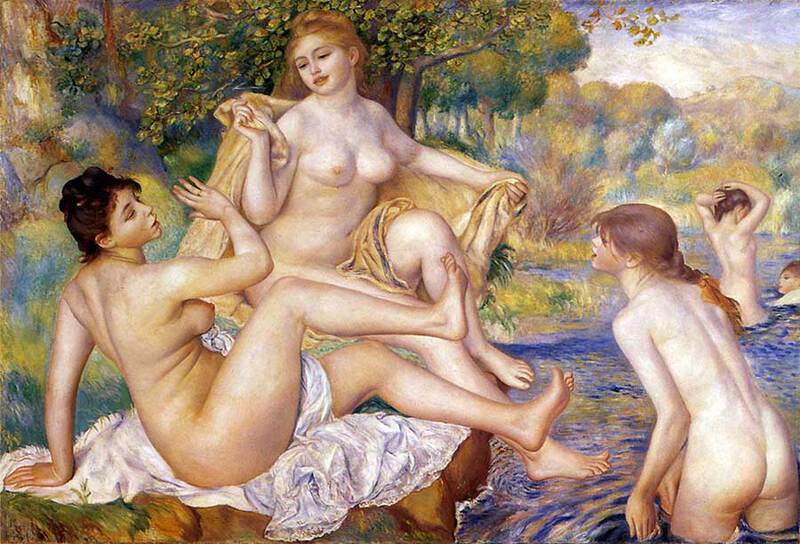
‘Les baigneuses’ or ‘The Bathers’ references the nudes of Rubens and Titian rather than reflecting the Impressionist technique. No trace of modernity or urban life can be found in this piece. Nonetheless, Renoir retained the soft, quick brushstrokes that were typical of the Impressionist style.
In many ways, these paintings can be seen as a reaction against the rapidly changing world that Renoir inhabited. As he grew older, he became more wedded to the idea of an idealised, bucolic past. His female nudes were perhaps his attempt to hold onto that image, at least in his art.
Renoir’s fellow Impressionist artists did not wholeheartedly support this new direction, as Cassatt quipped, he had resorted to painting
“enormously fat women with very small heads”.


